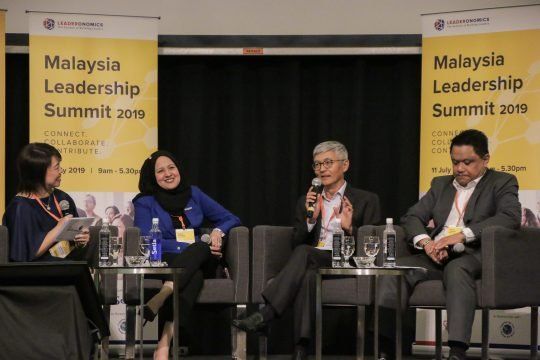Children, The Soul Of Your Organisation

So, I am going to be controversial and state that companies which still operate by a “customer-first” mantra are likely to be also-rans in the near future.
What’s easier to define, identify, locate, nurture and retain – a good customer or a great employee? More importantly, who can you truly leverage for sustained success?
We live in a time of unprecedented and accelerating change. Organisations risk slipping into irrelevance if they do not embrace the key architecture of a digitised economy and become themselves platforms for engagement, innovation and adaptability.
Organisational success is now, more than ever, dependent on employees bringing their passion, initiative and imagination to the table – their personal “gifts”, as management expert Gary Hamel puts it.
We need to make a structural shift in the way we nurture people from a young age and involve them in the development of a more creative economy.
But are we paying sufficient attention to the manner in which we are developing our children and graduates to engage effectively in a more open, flexible, collaborative and creative economy?
Our current worker-producing education systems are a result of the societal structure that was built around the economic engine of the last 150 years or so – one that is labour intensive. It isn’t natural for human beings to obediently conform to procedures, tend to machines or “brainless” tasks and pound away at it repeatedly – you have to train people to do that. And so we did.
This might interest you: How Are Children’s Rights And Businesses Connected?

I believe therefore that we need to make a structural shift in the way we nurture people from a young age and involve them in the development of a more creative economy.
As much as organisations will have to hack management systems and concepts, I would also like to suggest that sufficient attention be focused on a more holistic approach towards “people engagement” – in the broadest possible sense.
I draw lessons from Uber, Huffington Post, Grameen Bank, Kickstarter and GoFundMe as some examples of new people engagement models which have not only translated their engagement platforms into supernormal business results, but have enabled the “anyone can – be anything, do anything” mindset through these platforms.
So, we need creativity and inspiration to remain relevant, and we have to adopt new organisational architecture, and social technologies, to leverage these capabilities.
And the only meaningful source of these gifts lies in the unique generation of globally connected youth that are being nurtured and steered through a learning and development system that does not value these capabilities.
This video might interest you:
At Leaderonomics, we believe that it is no longer enough for organisations to simply keep building a case to be invested in the education sector through CSR or marketing initiatives.
It is a business imperative, and it is urgent. There is plenty of evidence to show that current education environments are not producing talent with the requisite capabilities, and that this capability gap is hindering growth, which has a vicious cyclical impact on job creations.
Also, it is not sufficient for organisations to only get involved for the purpose of nurturing their own talent pipeline.
In a world where existing customer pools are hyper-commoditised, we would like to challenge organisations to expand their engagement networks to include this audience pool – our youth – who will eventually translate into connected networks of employees, partners, customers, and more importantly, influencers and advocates.
One immediate starting point I believe organisations can (and must) act on is engaging in the development of their employees’ children.
What are some steps which organisations could take to build greater engagement with our youth via active participation in the education sector?

While there are a number of more conventional means of engagement (eg. school boards, speaking engagements, joint projects, embedded learning labs, entrepreneurial competitions) we would also like to invite you to join us in building new networks:
- Empowering students (in schools and universities) to implement “Make A Difference” projects within their school or community to inculcate shared community values and the desire to serve the greater good;
- Introducing elements of character, personal and leadership development in co-curricular activity (eg. sports, theatre, creative expression, etc);
- Supporting parent-teacher associations to foster the development of nurturing communities within schools;
- Working with student organisations and student bodies to assist students in seeking out “future-ready” credentials, not only relating to the soft-skills for workplace effectiveness, but the required self-starter and creative capabilities that are required for new job creation;
- Assisting and equipping management, faculty and student advisory teams at institutions of higher learning to create the appropriate experiences within their learning environments.
While the above highlight some of the areas in which we have attempted to make a difference, we are always on the look-out for partners and new opportunities to build deeper and more meaningful experiences on our journey towards building communities of love.
One immediate starting point I believe organisations can (and must) act on is engaging in the development of their employees’ children. There isn’t a better retention strategy than being able to be an ally in the development and the visible change your employees see in their children.
As Chase Jarvis aptly puts it, creativity may indeed be the new literacy. Passion, initiative, imagination – please stand up.
Devendran is a blessed husband and a proud father. While driving strategic initiatives at Leaderonomics, he believes that traditional approaches to management need to be hacked to enable society and organisations to truly transform in a digital world. To connect with him on strategies to hack your organisation and to collaborate with Leaderonomics in developing thriving learning communities, contact info@leaderonomics.com
Business
This article is published by the editors of Leaderonomics.com with the consent of the guest author.






